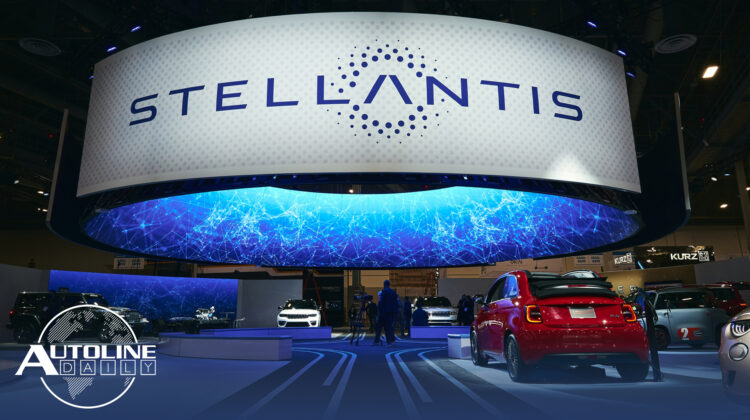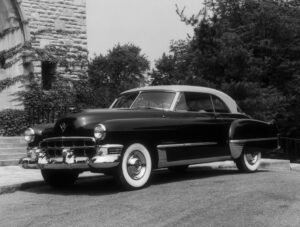
Follow us on social media:
Runtime: 10:11
0:00 UAW Strike Costs U.S. Economy $7.7 Billion
0:42 UAW Casualty: Stellantis Pulls Out Of CES
1:20 Unifor Sets Strike Date with Stellantis
1:45 Ford Announces Organizational Change
2:50 EU Battle of Direct Sales vs. Dealerships
4:15 BMW Surrenders, Goes with NACS
4:57 Red States Target EVs With Fees
6:00 BYD’s Q3 Profit to Soar
6:27 Japanese OEMs Partner on Hydrogen IC Engines
8:07 1948 Cadillac Honored for Plastics Breakthrough
Visit our sponsors to thank them for their support of Autoline Daily: Bridgestone, Intrepid Control Systems and Schaeffler.
This is Autoline Daily, the show dedicated to enthusiasts of the global automotive industry.
UAW STRIKE COSTS U.S. ECONOMY $7.7 BILLION
It’s Day 34 of the UAW strike and we’re starting to see more damage to the auto industry. The Anderson Economic Group estimates that the cost of the strike to the US economy is at $7.7 billion. But it’s actually higher than that because Anderson says its calculation included info up to October 12, which was 6 days ago. The total losses include OEM wages, lost production, supplier wages and earnings, as well as losses at dealerships and with their customers.
UAW CASUALTY: STELLANTIS PULLS OUT OF CES
Another casualty is Stellantis canceling its plans to go to CES in January, Stellantis blames the UAW strike and says it has to cut costs anywhere it can. The company has used CES for major concept unveils including the Fiat 500 Centoventi, the Chrysler Airflow, the Chrysler Synthesis, the Chrysler Portal, the Peugeot Inception and the Ram EV pickup. If it had any concepts to unveil at CES this coming January we’ll probably see Stellantis do some sort of online reveal instead.
UNIFOR SETS STRIKE DATE WITH STELLANTIS
Meanwhile, the Canadian union Unifor told Stellantis it has until October 29 to sign a new labor contract or face a strike. Unifor has already signed contracts with Ford and General Motors. Stellantis has more manufacturing facilities and employs more Unifor workers in Canada than any other automaker, so it has the most to lose.
FORD ANNOUNCES ORGANIZATIONAL CHANGE
Ford announced some organizational changes this morning. It says these represent the last cornerstone in its Ford+ growth plan. Kumar Gaholtra, who was running Ford Blue, the ICE side of the company, will now be the Chief Operating Officer of Ford, overseeing all industrial operations including all ICE and hybrid engineering, purchasing and manufacturing. Andrew Frick, who has a sales and marketing background, will now take over Ford Blue. Doug Field, who is in charge of developing EVs and software platforms will continue to do that. The same goes for Ted Cannis, who runs Ford Pro, the commercial vehicle side of the company–no change there either.
EU BATTLE OF DIRECT SALES VS DEALERSHIPS
It’s clear that the traditional dealership sales model has to evolve. But direct-to-consumer sales are not for everyone either. Which is why we think we’re seeing companies that only use dealers start to also offer direct sales and companies that only offer direct sales start to open dealerships as well. In August Stellantis announced that Citroen would be its first brand to offer direct sales and fixed pricing in Europe. Then last month XPeng said it would start phasing out direct sales in favor of dealerships in China. And now we’re seeing more. BMW will adopt direct sales and fixed pricing in Europe, in addition to its traditional dealerships. First will be the MINI brand at the beginning of 2024 and then BMW will follow in 2026. Somewhat interestingly, BMW will sell both new and used cars this way. Moving in the opposite direction is Chinese automaker NIO. Reuters reports it’s thinking about building a dealer network in Europe, instead of just offering direct sales and operating a couple of stores, as a way to speed up sales, which have been lower than expected. With so many companies going the other way from what they had been doing we think it’s inevitable that a hybrid sales model will be adopted in most of the world.
BMW SURRENDERS, GOES WITH NACS
In other BMW news, the Group announced that it will integrate Tesla’s NACS connector into its EVs starting in 2025 and will also gain access to its Supercharger network in North America at the same time. The new 5 Series, including the all-electric i5, which will launch in most markets before the end of November will obviously miss out on this benefit for a little bit, but no doubt it will be added to the list of approved vehicles. BMW also teased the new wagon version, the 5 Series Touring that will come out in the spring of next year and says it will have all the same powertrains as the sedan.
RED STATES TARGET EVs WITH FEES
There’s a big political divide in the U.S. over EVs. Democrats are pushing to get more on the road while Republicans claim nobody wants them. And now, mostly Republican controlled states are charging big fees to EV owners. At least eight states are charging $200 or more for annual registration fees and all but one, Pennsylvania, is controlled by Republicans. The GOP claims it’s an effort to make up for lost gas tax revenue, since EV owners don’t have to pay taxes on gas. But critics say it’s an effort to discourage EV purchases. While gas tax revenues have fallen over the last several years, that has more to do with gas powered vehicles being more fuel efficient. And according to state transportation officials, the extra EV fees won’t do much to help fill the funding gap and they’ll only boost budgets by 0.1% – 3%.
BYD’S Q3 PROFIT TO SOAR
BYD says its Q3 profits soared. The Chinese EV maker is forecasting that its Q3 net profit will range from $1.3 billion to $1.6 billion, an increase of 67%-102%, compared to a year ago. It’s incredible just how fast BYD is growing and it shows that it has no problem making money on the vehicles it sells.
JAPANESE OEMs PARTNER ON HYDROGEN IC ENGINES
We learned at the SAE Propulsion Conference that as many as 57% of the vehicles in the world could still have some sort of IC engine by 2050. So, one of the big questions will be, how do you make them cleaner? The answer might still be ICE, but ICE that runs on hydrogen fuel. Honda, Toyota, Kawasaki, Suzuki and Yamaha are all collaborating on a hydrogen-powered ICE vehicle that will compete in the off-road Dakar rally. The engine is a supercharged DOHC 4-cylinder with 4 valves per cylinder. This is just one test that they hope leads to the development of a hydrogen-powered ICE for small mobility applications. And there’s a number of benefits, including no worries about when or where or how long to charge, you get the same payload and range and there’s vastly reduced emissions. However, the best applications seem to be for big buses, trucks and ships, generators and construction equipment. A diesel bus costs about $170,000. A hydrogen-powered ICE bus is about $180,000. But a BEV bus is roughly $500,000 and a fuel cell powered bus would cost about $700,000. Hydrogen fuel is capable of powering all the ICE vehicles in the world with not a ton of modification required, but the biggest drawback is it takes a lot of water to make hydrogen fuel.
1948 CADILLAC HONORED FOR PLASTICS BREAKTHROUGH
Before we go we want to recognize a historical milestone in the use of new materials in the auto industry. The Society of Plastics Engineers or SPE is honoring the 1948 Cadillac Series 60, 61 and 62 for being the first to use acrylic taillight lenses. It was made possible by the invention of a new polymer discovered by Dr. Otto Röhm in 1932, called polymethylmethacrylate. The SPE says it was a game changer in automotive design, “replacing ground glass and enabling a renaissance of new lighting designs for all OEMs.” You know, plastic light covers are something that we take for granted today, but back then it was quite a breakthrough.
And that little history lesson brings us to the end of today’s show. Thanks for tuning in.
Thanks to our partner for embedding Autoline Daily on its website: WardsAuto.com









Sean, When you ‘burn’ hydrogen, you get back the water that was used to make the hydrogen in the first place. This is true even if the hydrogen was made from natural gas. So I don’t understand the concern about the amount of water used (but not consumed) in the process.
I like the old format so I can quickly click on the topics of my interest
Those EV surcharges are punitive, in that they amount to a lot more than the state gas tax for a normal vehicle, except for those driven far more than an average number of miles.
It takes a lot of electricity to produce “clean” hydrogen. Most currently produced hydrogen is from natural gas, and would make no sense to use for IC engines. For hydrogen to make sense as a fuel, we need a lot of juice from wind and solar to power the electrolyzers.
Not sure if hydrogen ICE is the solution, hydrogen takes a lot of energy and operational costs will be high… ICE vehicles count on the road by 2050 will still be high, but because cars made in 2030 will still be in use.
For the state I live in, gas tax is 0.70 cents per gallon. The average car travels 12,000 miles per year. Assuming they drive something that gets 30MPG, that driver is paying $280 per year in fuel tax.
If we look at EV weight versus ICE weight, the EVs are closer to trucks in weight. Weight damages the roads. So the average truck driving 12,000 miles per year which gets 22MPG would cost that driver $382 per year.
An EV driver paying $200 per year in cost to support the roads they drive on is a bargain.
For the state I live in, gas tax is 0.70 cents per gallon. The average car travels 12,000 miles per year. Assuming they drive something that gets 30MPG, that driver is paying $280 per year in fuel tax.
If we look at EV weight versus ICE weight, the EVs are closer to trucks in weight. Weight damages the roads. So the average truck driving 12,000 miles per year which gets 22MPG would cost that driver $382 per year.
An EV driver paying $200 per year in cost to support the roads they drive on is a bargain. Them paying $0 per year is a travesty and not equitable.
Are you saying there isn’t any Democratic run states that have implemented fees on EVs to recover gas tax? I’d say it’s more about those leaders using simple logic to know as these vehicles become more prevalent that there will be a gap in revenue to be used for road repair. Everyone should pay their part regardless of what powers your vehicle. Seems fair. Critics say $200 is to discourage buying an EV meanwhile providing up to $7500 in tax breaks. I dont think a $200 fee on a 50K vehicle is going to change anyone’s mind.
I think if you include who made this claim or did this study, the whole picture will become much more clear.
I’m of the opinion we need an “all-hands-on-deck” approach to transportation. Each variety has it’s own benefits and downfalls. Electric car owners complaining about road-use fees would probably complain louder when their EV hits a pothole deep enough to bottom out their car causing extensive damage. Due to their extra weight, they contribute to road wear moreso than much lighter vehicles. Hydrogen has promise, and in time, better ways to produce it may be discovered. There may be more discoveries in synthethic fuels as well. Let’s not forget the original diesel engine was designed to run on vegetable oil, peanut oil, or coal tar, not crude oil.
Ohio’s gas tax is 38.5 per gallon and using your figures for a truck (which I rarely get 22 mpg) but still it comes out to $210 a year in gas tax. Seems like a reasonable fee.
Notice the start-ups are the ones going to dealerships while legacy builders are going to on-line. Its because the Chinese star-ups need to be able to give that warm fuzzy feeling to consumers they are legit and there is a place to get the vehicle serviced. Something the legacy’s already have. No doubt dealerships will decline overall for those that have them and the Chinese will not open near as many as others that sell similar volumes.
A Toyota Crown weighs more than a Tesla Model 3, but you’d need to drive it 17K miles in Georgia, much more than average mileage, to pay gas tax equal to the EV surcharge. That’s including the federal tax, and I doubt if Georgia donates any of the surcharge to the federal government.
Yes, I doubt if those surcharges have much effect on what cars people buy, but having a punitive tax on EVs does not make sense. They just need to tax on miles driven, to replace both the state and federal gas tax.
If/when Chinese companies start selling in the US, they will probably operate like Tesla, having a few factory stores/service centers, but deliver the vehicle to you door if you want.
About the new comment format:
The wasted screen estate of the new format is pretty rough. The four sponsor icons should display on one line. Furthermore, the line spacing could be reduced improving readability.
Missing, we used to have comment numbers when answering earlier postings … please bring them back.
Love the timed edit window. WELL DONE.
Thanks for the taillight history!
About the EV “hippy tax,” I have two, 2017. BMW i3-REx and 2019 Model 3 Std Rng Plus, and this month, it cost $1,000 for the tags. However, it costs $2.75/100 mi for the BMW and $2.50/100 mi for the Tesla. Each day starts with them charged up. I shop at stores with free charging.
EV maintenance has been window washer fluid, recent cabin air filter, and my first set of long lasting, low rolling resistance tires (yet to be replaced.) No brake wear, no oil changes, no transmission issues, and no engine air filter. Just one big annual tag bill fueling Republican resentment.
The expected, 116,000 mi Tesla battery degradation is down to 215 of 240 mi. Happily, Tesla added SuperChargers faster than my range decrease. As for the 59,000 mi BMW i3-REx, it benchmarks at 106 mi with a built-in engine-generator that avoids the CCS-1 disaster. The BMW is my City car while the Tesla is the long distance master.
The EV “hippy tax” motivates my donations to Democrats. Happily, I’m saving enough driving EVs to be generous to the Democrats. Apparently the Republicans don’t want my vote or campaign money. So I return the favor.
I have to completely agree with Merkur and Lambo about road fees comments above (and I too wish we retained the numbered comments to reference follow-up comments).
And depending on the amount of water produced, by combustion of H2, it may require a tank to collect it; or else, we may all be driving on wet roads constantly. Of course, this might only be of concern in urban or high traffic areas.
Bob I hope your donating in the millions as it’s been proven that bills have an equal chance of being passed regardless of public support. So, unless you have a lobbyist working for you good luck. They don’t care about your position while more than happy to accept your donation. Considering the condition our country is in and the draft to send another 100 billion overseas I’m not sure how you can send the Democratic party any support in good faith. But even Hitler had supporters I suppose.
Chuck, about a gallon of water is produced from burning a gallon of gasoline. Not a lot more water would come from burning the amount of hydrogen to produce a similar amount of energy.
The water from burning H2 would exit the exhaust as vapor, like the water from burning gasoline, only without CO2 mixed in. It would not make puddles on the ground.
Bob Wilson, what stores in your area have free charging? I don’t know of any in either of the places I live. An exception, would be for the Model S buyers who got in on the free charging for life. There are “superchargers” at a Meijer store in Kokomo, IN.
I’m surprised at how many people here favor EV surcharges that amount to more than reasonably efficient vehicles driven average number of miles would pay in gas tax. At least it’s that way in some states. I agree, though, that a fair “make up” for the gas tax needs to be implemented, but based on the weight of the vehicle, and miles driven. Presumably, that will happen, as EVs make up a larger portion of the fleet.
So we are complaining about the cost of the ‘hippy tax’ to help support road maintenance where you drive and at the same time bragging about all the money you save by driving EVs. Even going so far as to save enough to ‘generously’ donate to politicians. Can’t make this stuff up.
How forward thinking were the folks at Cadillac all those years ago?
An aunt had a ’49 Cadillac, and the thing I remember about it as a little kid, was that the gas cap was under the left tail light. As a 5 year old, I didn’t realize that the lens was probably plastic, while most were glass at the time.
There used to be a time that Cadillac introduced all the new latest technical innovations and eventually it trickled down to the lesser brands. That was back when it was known as the luxury standard of the world. Some time during the 70s/80s GM decided it would be best to trickle up things from Chevrolet and make Cadillac a warmed up Chevrolet. They lost this technical innovation and more importantly lost the title of the luxury standard of the world. These days their products are mostly a BMW also ran. No real innovation going on with Cadillac. I am hopeful that the celestiq signals that Cadillac will return to be the innovators again and reclaim the luxury standard of the world, but I am highly skeptical. I don’t think GM management has the strength to allow Cadillac to stray too far into innovation.
It has become increasingly difficult to differentiate “premium/luxury” brands from the rest. Every car now has the convenience and safety features that once differentiated a Cadillac or Benz from a Chevy or VW. The expensive ones may be a little quieter, or have a nicer interior, but the difference is not that great. The one thing Cadillac has is their remaining two cars, CT4 and CT5, but the BMWs perform better, for only a little more money.
Looking at the Asians, the Toyota Highlander is much less expensive than the related Lexus RX, but has more room, and seems equally comfortable. Then, the Lexus specifies premium fuel, even for the non-turbo hybrid, all in the name of 3 more hp. Yes, I don’t buy “premium” brands, except Porsche, where there is no equivalent car from a related mass market brand.